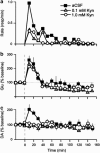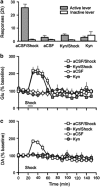Heroin self-administration experience establishes control of ventral tegmental glutamate release by stress and environmental stimuli
- PMID: 22948979
- PMCID: PMC3499717
- DOI: 10.1038/npp.2012.167
Heroin self-administration experience establishes control of ventral tegmental glutamate release by stress and environmental stimuli
Abstract
Heroin and cocaine have very different unconditioned receptor-mediated actions; however, in the brain circuitry of drug-reward and motivation, the two drugs establish common conditioned consequences. A single experience with either drug can change the sensitivity of ventral tegmental area (VTA) dopamine neurons to glutamatergic input. In the case of cocaine, repeated intravenous self-administration establishes de novo VTA glutamate release and dopaminergic activation in response to conditioned stimuli and mild footshock stress. Here we determined whether repeated self-administration of heroin would establish similar glutamate release and dopaminergic activation. Although self-administration of heroin itself did not cause VTA glutamate release, conditioned glutamate release was seen when rats expecting rewarding heroin were given nonrewarding saline in its place. Mild footshock stress also caused glutamate release in heroin-trained animals. In each case, the VTA glutamate release was accompanied by elevations in VTA dopamine levels, indicative of dopaminergic activation. In each case, infusion of the ionotropic glutamate antagonist kynurenic acid blocked the VTA dopamine release associated with VTA glutamate elevation. Although glutamate levels in the extinction and reinstatement tests were similar to those reported in cocaine studies, the effects of heroin self-administration itself were quite different from what has been seen during cocaine self-administration.
Figures




Similar articles
-
Reinstatement of cocaine seeking by hypocretin (orexin) in the ventral tegmental area: independence from the local corticotropin-releasing factor network.Biol Psychiatry. 2009 May 15;65(10):857-62. doi: 10.1016/j.biopsych.2009.01.018. Epub 2009 Feb 28. Biol Psychiatry. 2009. PMID: 19251246 Free PMC article.
-
Stress-induced relapse to cocaine seeking: roles for the CRF(2) receptor and CRF-binding protein in the ventral tegmental area of the rat.Psychopharmacology (Berl). 2007 Aug;193(2):283-94. doi: 10.1007/s00213-007-0782-3. Epub 2007 Apr 17. Psychopharmacology (Berl). 2007. PMID: 17437087
-
VTA glutamatergic projections to the nucleus accumbens suppress psychostimulant-seeking behavior.Neuropsychopharmacology. 2024 Nov;49(12):1905-1915. doi: 10.1038/s41386-024-01905-3. Epub 2024 Jun 26. Neuropsychopharmacology. 2024. PMID: 38926603 Free PMC article.
-
A ventral tegmental CRF-glutamate-dopamine interaction in addiction.Brain Res. 2010 Feb 16;1314:38-43. doi: 10.1016/j.brainres.2009.09.101. Epub 2009 Oct 1. Brain Res. 2010. PMID: 19800323 Free PMC article. Review.
-
Ventral tegmental glutamate: a role in stress-, cue-, and cocaine-induced reinstatement of cocaine-seeking.Neuropharmacology. 2009;56 Suppl 1(Suppl 1):174-6. doi: 10.1016/j.neuropharm.2008.06.008. Epub 2008 Jun 13. Neuropharmacology. 2009. PMID: 18598707 Free PMC article. Review.
Cited by
-
Ventral Tegmental Area Afferents and Drug-Dependent Behaviors.Front Psychiatry. 2016 Mar 7;7:30. doi: 10.3389/fpsyt.2016.00030. eCollection 2016. Front Psychiatry. 2016. PMID: 27014097 Free PMC article. Review.
-
Glutamatergic transmission in drug reward: implications for drug addiction.Front Neurosci. 2015 Nov 5;9:404. doi: 10.3389/fnins.2015.00404. eCollection 2015. Front Neurosci. 2015. PMID: 26594139 Free PMC article. Review.
-
Relapse to opioid seeking in rat models: behavior, pharmacology and circuits.Neuropsychopharmacology. 2019 Feb;44(3):465-477. doi: 10.1038/s41386-018-0234-2. Epub 2018 Oct 6. Neuropsychopharmacology. 2019. PMID: 30293087 Free PMC article. Review.
-
The reinstatement model of drug relapse: recent neurobiological findings, emerging research topics, and translational research.Psychopharmacology (Berl). 2013 Oct;229(3):453-76. doi: 10.1007/s00213-013-3120-y. Epub 2013 May 18. Psychopharmacology (Berl). 2013. PMID: 23685858 Free PMC article. Review.
-
Area-specific analysis of the distribution of hypothalamic neurons projecting to the rat ventral tegmental area, with special reference to the GABAergic and glutamatergic efferents.Front Neuroanat. 2015 Sep 4;9:112. doi: 10.3389/fnana.2015.00112. eCollection 2015. Front Neuroanat. 2015. PMID: 26388742 Free PMC article.
References
-
- Anderson SM, Bari AA, Pierce RC. Administration of the D1-like dopamine receptor antagonist SCH-23390 into the medial nucleus accumbens shell attenuates cocaine priming-induced reinstatement of drug-seeking behavior in rats. Psychopharmacology. 2003;168:132–138. - PubMed
-
- Bozarth MA, Wise RA. Heroin reward is dependent on a dopaminergic substrate. Life Sci. 1981;29:1881–1886. - PubMed
Publication types
MeSH terms
Substances
Grants and funding
LinkOut - more resources
Full Text Sources
Medical

